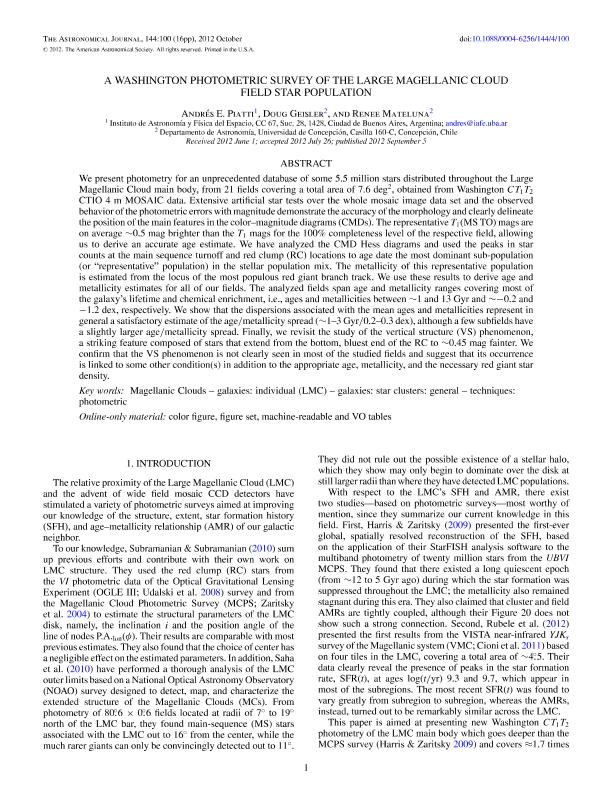Mostrar el registro sencillo del ítem
dc.contributor.author
Piatti, Andres Eduardo

dc.contributor.author
Geisler, Doug
dc.contributor.author
Mateluna, Renee
dc.date.available
2017-07-04T20:21:52Z
dc.date.issued
2012-10
dc.identifier.citation
Piatti, Andres Eduardo; Geisler, Doug; Mateluna, Renee; A Washington photometric survey of the Large Magellanic Cloud field star population; IOP Publishing; Astronomical Journal; 144; 10-2012; 100,1-16
dc.identifier.issn
0004-6256
dc.identifier.uri
http://hdl.handle.net/11336/19532
dc.description.abstract
We present photometry for an unprecedented database of some 5.5 million stars distributed throughout the Large Magellanic Cloud main body, from 21 fields covering a total area of 7.6 deg2, obtained from Washington CT1T2 CTIO 4 m MOSAIC data. Extensive artificial star tests over the whole mosaic image data set and the observed behavior of the photometric errors with magnitude demonstrate the accuracy of the morphology and clearly delineate the position of the main features in the color–magnitude diagrams (CMDs). The representative T1(MS TO) mags are on average ∼0.5 mag brighter than the T1 mags for the 100% completeness level of the respective field, allowing us to derive an accurate age estimate. We have analyzed the CMD Hess diagrams and used the peaks in star
counts at the main sequence turnoff and red clump (RC) locations to age date the most dominant sub-population (or “representative” population) in the stellar population mix. The metallicity of this representative population is estimated from the locus of the most populous red giant branch track. We use these results to derive age and metallicity estimates for all of our fields. The analyzed fields span age and metallicity ranges covering most of the galaxy’s lifetime and chemical enrichment, i.e., ages and metallicities between ∼1 and 13 Gyr and ∼−0.2 and
−1.2 dex, respectively. We show that the dispersions associated with the mean ages and metallicities represent in general a satisfactory estimate of the age/metallicity spread (∼1–3 Gyr/0.2–0.3 dex), although a few subfields have
a slightly larger age/metallicity spread. Finally, we revisit the study of the vertical structure (VS) phenomenon, a striking feature composed of stars that extend from the bottom, bluest end of the RC to ∼0.45 mag fainter. We confirm that the VS phenomenon is not clearly seen in most of the studied fields and suggest that its occurrence is linked to some other condition(s) in addition to the appropriate age, metallicity, and the necessary red giant star density.
dc.format
application/pdf
dc.language.iso
eng
dc.publisher
IOP Publishing

dc.rights
info:eu-repo/semantics/openAccess
dc.rights.uri
https://creativecommons.org/licenses/by-nc-sa/2.5/ar/
dc.subject
Lmc
dc.subject.classification
Astronomía

dc.subject.classification
Ciencias Físicas

dc.subject.classification
CIENCIAS NATURALES Y EXACTAS

dc.title
A Washington photometric survey of the Large Magellanic Cloud field star population
dc.type
info:eu-repo/semantics/article
dc.type
info:ar-repo/semantics/artículo
dc.type
info:eu-repo/semantics/publishedVersion
dc.date.updated
2017-07-04T14:09:05Z
dc.journal.volume
144
dc.journal.pagination
100,1-16
dc.journal.pais
Estados Unidos

dc.description.fil
Fil: Piatti, Andres Eduardo. Consejo Nacional de Investigaciónes Científicas y Técnicas. Oficina de Coordinación Administrativa Ciudad Universitaria. Instituto de Astronomía y Física del Espacio. - Universidad de Buenos Aires. Facultad de Ciencias Exactas y Naturales. Instituto de Astronomía y Física del Espacio; Argentina
dc.description.fil
Fil: Geisler, Doug. Universidad de Concepción; Chile
dc.description.fil
Fil: Mateluna, Renee. Universidad de Concepción; Chile
dc.journal.title
Astronomical Journal

dc.relation.alternativeid
info:eu-repo/semantics/altIdentifier/doi/http://dx.doi.org/10.1088/0004-6256/144/4/100
dc.relation.alternativeid
info:eu-repo/semantics/altIdentifier/url/http://iopscience.iop.org/article/10.1088/0004-6256/144/4/100
Archivos asociados
